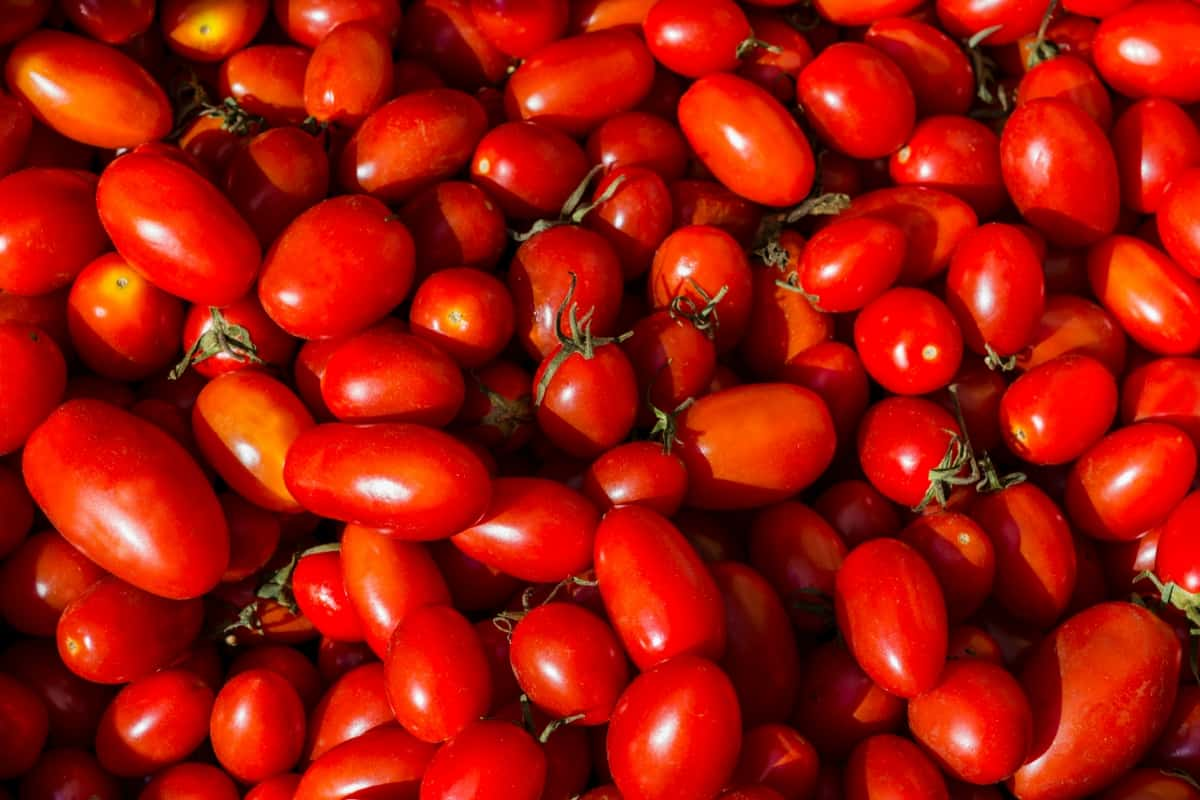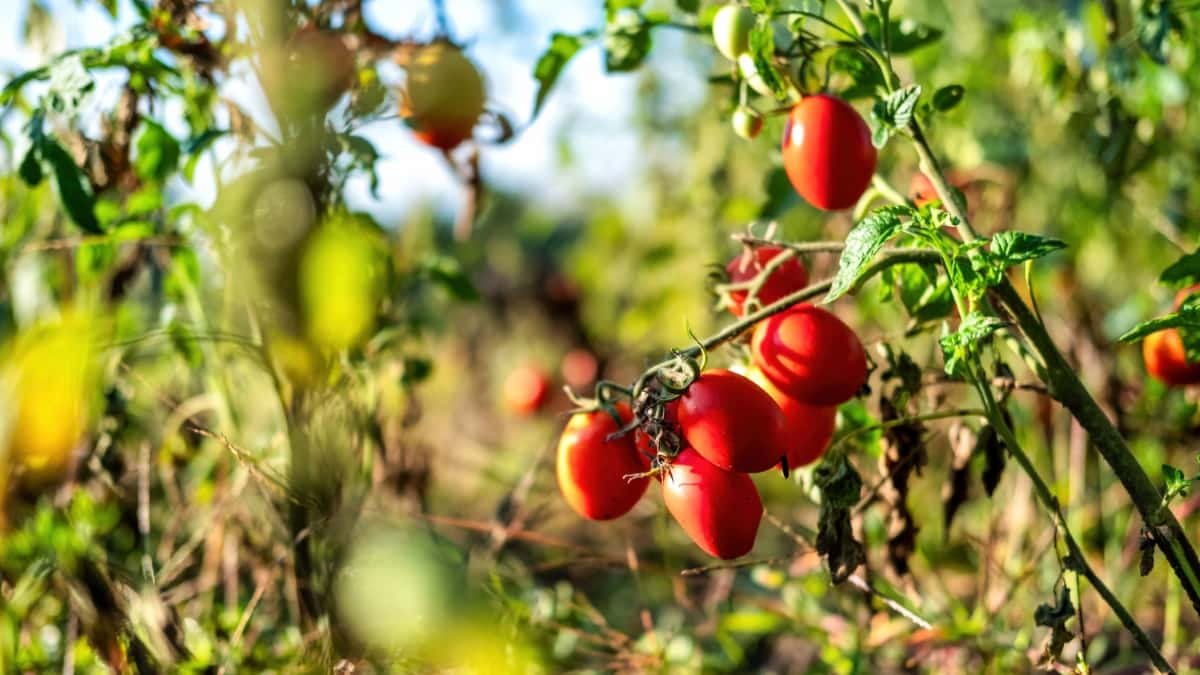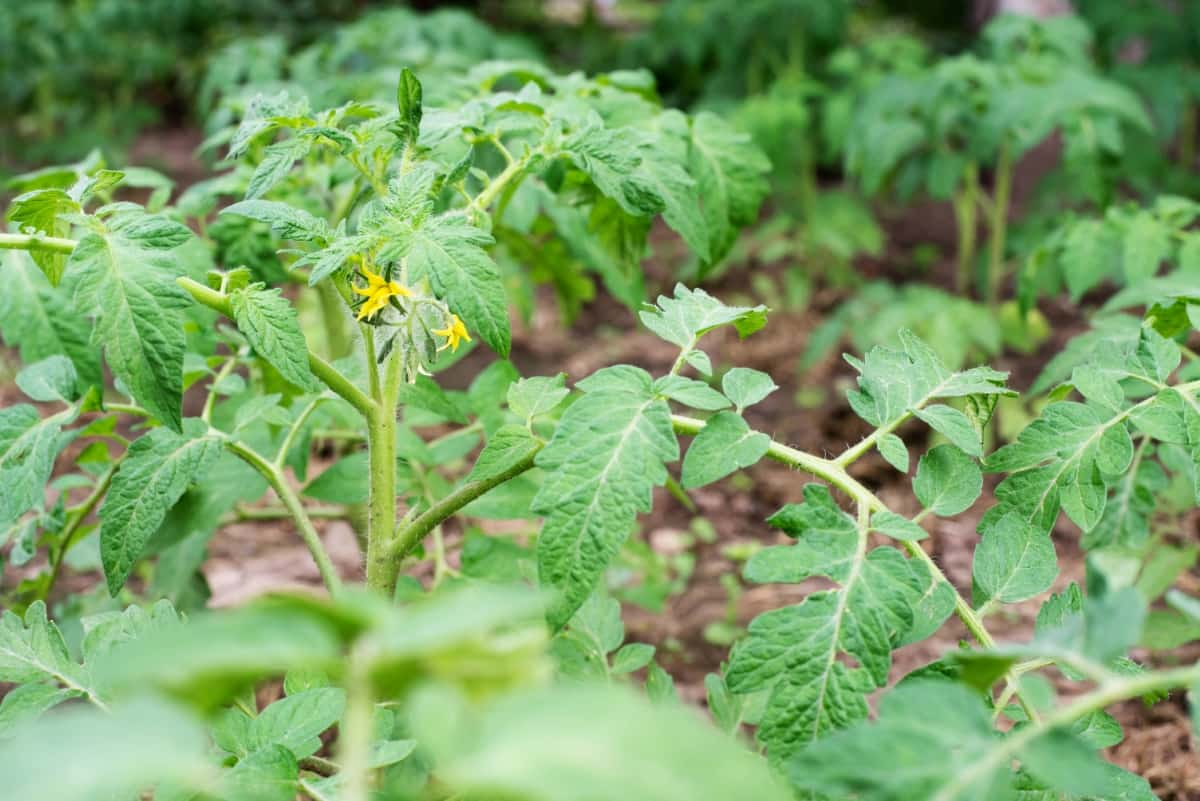Grape tomatoes are small, bite-sized tomatoes that are bursting with flavor. Growing your grape tomatoes can be a rewarding experience, allowing you to enjoy the freshest and most delicious tomatoes from your garden. Growing grape tomatoes from seeds is easy; This guide will take you through the step-by-step process of growing and caring for grape tomatoes, from planting the seeds to harvesting the ripe fruits.

How to Grow Grape Tomatoes
Best Soil Conditions for Growing Grape Tomatoes
Grape tomatoes require a well-draining potting mix or potting soil. You can purchase potting mix from a garden center or prepare your own by mixing equal parts of peat moss, vermiculite, and perlite. The soil should be fertile, with a pH range between 6.0 to 6.8.
Choosing the Right Grape Tomato Variety
Grape tomatoes can be grown indoors and outdoors, depending on your preference and available space. Consider the growing conditions in your area, such as sunlight, temperature, and soil type, and select a variety well-suited to those conditions. Given below are some Grape tomato varieties list
- Sugary: Sugary grape tomatoes are small and oval-shaped, with a deep red color. They have a rich, sweet flavor and a firm texture.
- Juliet: Juliet tomatoes are a hybrid variety that produces long clusters of small, oval-shaped fruits. It is one of the best grape tomatoes for containers.
- Sweet Zen: Sweet Zen tomatoes are small, round, and bright red. They have a balanced flavor that is both sweet and tangy.
- Tami G: Tami G tomatoes are small, round, and vibrant red. They have a sweet and tangy flavor that is both refreshing and satisfying.
Starting Grape Tomato Seeds Indoors
Fill the trays or containers with seed starting mix or potting soil, leaving about 1 inch of space at the top. Gently tamp down the soil in the trays to remove any air pockets.
Sow The Grape Tomato Seeds
- Place 1 or 2 grape tomato seeds on top of the soil in each cell or container.
- Cover your tomato seeds with a thin layer of soil approximately 1/4 inch deep.
- Lightly water the soil using a watering can or spray bottle.
Provide the Necessary Conditions for Germination
- Place a clear plastic dome or wrap over the seed starting trays or containers to create a mini greenhouse effect.
- Position the trays or containers in a warm location with indirect sunlight, such as a sunny windowsill or under grow lights.
- Maintain a temperature of around 21 to 27 degrees Celsius) for optimal germination.
Monitor and Care for the Seeds
- Check the soil’s moisture level regularly and water as needed to keep it moist but not waterlogged.
- Remove the plastic dome or wrap once the seeds have germinated, usually within 7 to 14 days.
- Place the trays or containers in a location with bright and direct sunlight for at least 6 to 8 hours a day.
In case you missed it: How to Grow Black Krim Tomatoes: A Guide to Planting, Care, and Harvest

Transplanting Grape Tomato Seedlings
For Transplanting and growing grape tomatoes indoors, first, choose a suitable location for transplanting the grape tomato seedlings. Ensure the spot receives at least six to eight hours of direct sunlight daily. Prepare the larger pots or garden beds with high-quality potting soil. Dig a hole in the prepared location slightly larger than the seedling’s root ball. Space the holes at least 18-24 inches apart for proper growth and airflow.
Gently remove the grape tomato seedlings from their original containers, taking care not to damage their delicate roots. Place each seedling in the prepared hole, ensuring that the top of the root ball is level with the soil surface. After transplanting, water the seedlings thoroughly to settle the soil and provide the necessary moisture for their growth. Use a watering can or soaker hose with a gentle spray nozzle to avoid damaging the young plants.
Providing Adequate Sunlight for Grape Tomatoes
Sunlight is essential for the growth and development of grape tomatoes. To provide adequate sunlight for grape tomatoes, it is crucial to choose the right location for planting. Select a spot that receives at least six to eight hours of direct sunlight every day. Grape tomatoes thrive in full sun, so avoid planting them in areas that are shaded or receive partial sunlight for extended periods.
If you are growing grape tomatoes in pots, place them in an area where they can receive maximum sunlight exposure. Consider placing the containers near south-facing windows or balconies to ensure they receive ample sunlight throughout the day.
Watering Requirements for Grape Tomatoes
Watering Frequency: Grape tomatoes require regular watering to thrive. They have shallow roots, so it is important to water them consistently to maintain soil moisture. Generally, water grape tomatoes every 2-3 days or when the soil’s top layer is dry.
Watering Depth: When watering grape tomatoes, ensuring the water reaches the root zone is crucial. Deep watering promotes strong root development and helps the plants withstand dry spells. Allowing the water to penetrate the soil thoroughly.
In case you missed it: How to Grow Better Boy Tomatoes: A Guide to Planting, Care, and Harvest

Fertilizing Grape Tomato Plants
- Like all tomato plants, Grape tomatoes are heavy feeders requiring nutrient-rich soil to grow and produce fruit.
- If you want to maximize your yield of Grape tomatoes, here’s the science you need to know.
- Nitrogen helps a plant produce healthy and robust foliage. The first couple of fertilizer doses should be high in nitrogen.
- This will give the plant a strong base to grow and produce fruit later.
- Keep an eye out for flower buds as the growing season progresses,
- As soon as they appear, switch to a high-phosphorus-and-potassium fertilizer. There are two reasons for this.
- Phosphorus and Potassium encourage flowering, which in turn means more fruit.
Pruning and Supporting Grape Tomato Plants
When to Prune Grape Tomato Plants
Pruning grape tomato plants should ideally be done throughout the growing season. However, it is particularly important to prune them during the early stages to establish a strong framework and remove any damaged or diseased branches.
How to Support Grape Tomato Plants
- Install the chosen support system before planting the grape tomato plants, ensuring it is secure and properly anchored.
- As the plants grow, gently guide the main stem towards the support structure, tying it loosely with soft plant ties or twine.
- Regularly check the ties and adjust them as needed to avoid constriction or damage to the plant.
- If using tomato cages, gently weave the branches through the openings to prevent them from sprawling.
Managing Pests and Diseases in Grape Tomatoes
Identify the common pests that affect grape tomatoes. Some of the most prevalent pests include aphids, whiteflies, tomato hornworms, and spider mites. These pests can cause accountable damage to the plants, leading to yellowing leaves, stunted growth, and reduced fruit.
- Beneficial Insects: Introduce beneficial insects like ladybugs, lacewings, and parasitic wasps, which feed on common pests like aphids and whiteflies.
- Neem Oil: Apply neem oil, a natural insecticide, to deter pests and control their populations. Follow the label instructions for proper application.
Disease Management
In addition to pests, grape tomatoes are susceptible to various diseases, including blight, powdery mildew, and bacterial spot. To manage these diseases effectively, consider the following:
- Disease-Resistant Varieties: Select grape tomato varieties bred for disease resistance, reducing the likelihood of infection.
- Proper Watering: Avoid overhead watering, as it can spread fungal diseases. Instead, water the plants at the base to keep the foliage dry.
Harvesting and Storing Grape Tomatoes
Timing: Grape tomatoes are ready for harvest when they have reached their full color and have a firm texture. They should easily detach from the vine with a gentle twist.
Harvesting: To harvest grape tomatoes, hold the tomato vine gently with one hand and use the other hand to twist and detach the ripe tomatoes from the stem. Avoid pulling or tugging forcefully, as this may damage the tomatoes or the plant.
Sorting: Once harvested, sort through the grape tomatoes and remove any damaged or overripe ones. This will help prevent spoilage during storage. Moisture is the enemy of grape tomatoes. Make sure to keep them dry during storage. Please do not wash them until you are ready to consume them, as excess moisture can cause them to spoil quickly.
In case you missed it: Tomato Companion Plants: What to Plant and What Not to Plant with Tomatoes

Conclusion
Growing and caring for grape tomatoes can be a gratifying experience for any home gardener. By following the instructions discussed in this guide, you can have more chances to get a bountiful harvest of sweet and delicious grape tomatoes. You’ll be rewarded with a successful grape tomato harvest season after season with proper care and attention.
- Feed Your Flock for Less: Top 10 Tips to Save on Chicken Feed
- Ultimate Guide to Ossabaw Island Hog: Breeding, Raising, Diet, and Care
- Hatching Answers: The Top 10 Reasons Your Chickens Aren’t Laying Eggs
- Eggs and Economics: Breaking Down the Cost of Raising Backyard Chickens
- Defend Your Greens: Proven Methods to Keep Iguanas Out of Your Garden
- Ultimate Guide to Cinnamon Queen Chicken: A Comprehensive Guide for Beginners
- Ultimate Guide to California Tan Chicken: Breeding, Raising, Diet, Egg-Production and Care
- Ultimate Guide to Marsh Daisy Chicken: Breeding, Raising, Diet, and Care
- 10 Types of Chicken Farming Businesses You Can Start for Profits